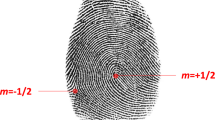Abstract
Molecular dynamics (MD) simulations have been used to examine the friction between commensurate self-assembled monolayers (SAMs) on Au (111). The discrepancy between sawtoothed friction force and the discontinuous molecular movements reveals the complex dynamics of the closed-packing chains under shearing. Molecules in the lower monolayer can be divided into two groups with a phase difference of π. The periodic motion of the molecules is not synchronous with the frictional stick-slip loops, which result in a second-order valley in friction curves.
Similar content being viewed by others
References
I. L. Singer and H. M. Pollock (eds.) Fundamentals of Friction: Macroscopic and Microscopic Processes (Kluwer Academic Publishers, Dordrecht, 1992).
B. N. J. Persson and E. Tosatti (eds.) Physics of Sliding Friction (Kluwer Academic Publishers, Dordrecht, 1996).
M. O. Robbins and M. H. Muser, in: Handbook of Modern Tri-bology, ed. B. Bhushan CRC Press, 2000).
G. M. McClelland and J. N. Glosli, Friction at the Atomic Scale. (1992) p. 405.
S. Aubry, Physica D 7 (1983) 240.
P. Bak, Rep. Progr. Phys. 45 (1982) 587.
C. M. Mate, G. M. McClelland, R. Erlandsson and S. Chiang, Phys. Rev. Lett. 59 (1987) 1942.
S. Morita, S. Fujisawa and Y. Sugawara, Surf. Sci. Rep. 23 (1996) 1.
D. Tomanek, W. Zhong and H. Thomas, Europhys. Lett. 15 (1991) 887.
T. Gyalog, M. Bammerlin, R. Luthi, E. Meyer and H. Thomas, Europhys. Lett. 31 (1995) 269.
J. Krim, D. H. Solina and R. Chiarello, Phys. Rev. Lett. 66 (1991) 181.
M. Cieplak, E. D. Smith and M. O. Robbins, Science 265 (1994) 1209.
M. O. Robbins and J. Krim, MRS Bull. 23 (1998) 23 andref. therein.
B. N. J. Persson, Phys. Rev. B 48 (1993) 18140.
M. R. Sorensen, K. W. Jacobsen and P. Stoltze, Phys. Rev. B 53 (1996) 2101.
J. A. Harrison and S. S. Perry, MRS Bull. 23 (1998) 27and ref. therein.
G. He, M. H. Muser and M. O. Robbins, Science 284 (1999) 1650.
G. He and M. O. Robbins, Tribol. Lett. 10 (2001) 7.
M. D. Perry and J. A. Harrison, J. Phys. Chem. B 101 (1997) 1364.
A. Ulman, An Introduction to Ultrathin Organic Films (Academic Press, Boston, 1991).
C. D. Frisbie, L. F. Rozsnyai, A. Noy, M. S. Wrighton and C. M. Lieber, Science, 265 (1994) 2071.
X. D. Xiao, G. Y. Liu, D. H. Charych and M. Salmeron, Langmuir 12 (1996) 235.
E. Barrena, S. Kopta, D. F. Ogletree, D. H. Charych and M. Salmeron, Phys. Rev. Lett. 82 (1999) 2880.
J. N. Glosli and G. M. McClelland, Phys. Rev. Lett. 70 (1993) 1960.
T. Ohzono, J. N. Glosli and M. Fujihira, Jpn. J. Appl. Phys. 37 (1998) 6335.
M. Fujihira and T. Ohzono, Jpn. J. Appl. Phys. 38 (1999) 3918.
A. Koike and M. Yoneya, J. Chem. Phys. 105 (1996) 6060.
K. J. Tupper, and D. W. Brenner, Thin Solid Films, 253 (1994) 185.
J. Hautman and M. L. Klein, J. Chem. Phys. 91 (1989) 4994.
U. Landman, W. D. Luedtke, N. A. Burnham and R. J. Colton, Science 248 (1990) 454.
The lattice constant of gold (111) is a = 2. 884 Å, and the NN distance of monolayers is √ 3a = 5 Å. In one stick-slip segment, the relative displacement between tail groups of opposite monolayers in the x direction is √ 3a/2 either of them taking half, namely √3a/4. In figure 4(a) the distance between adjacent MPs (R and F) of head groups in the x direction is √3a/6 which is 2/3 of the displacement of trail groups in one segment.
E. Barrena, C. Ocal and M. Salmeron, J. Chem. Phys. 113 (2001) 2413
E. Barrena, C. Ocal and M. Salmeron, J. Chem. Phys. 114 (2001) 4210.
Author information
Authors and Affiliations
Rights and permissions
About this article
Cite this article
Zhang, T., Wang, H. & Hu, Y. Atomic Stick-Slip Friction Between Commensurate Self-Assembled Monolayers. Tribology Letters 14, 69–76 (2003). https://doi.org/10.1023/A:1021743901788
Issue Date:
DOI: https://doi.org/10.1023/A:1021743901788




